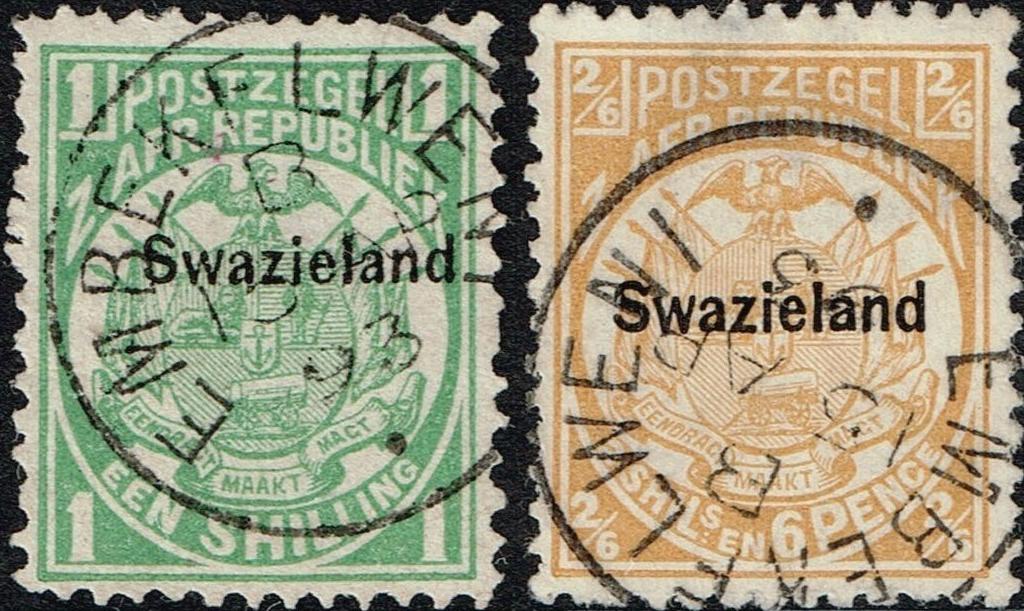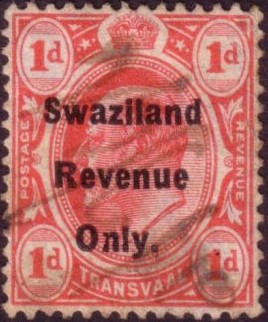 |
|||||
|
|||||
| Preview of Stamps Catalogue: VOLUME 1 |
 |
|||||
|
|||||
| Preview of Stamps Catalogue: VOLUME 1 |
Swasiland - Swaziland
Return To Catalogue - South Africa
Note: on my website many of the
pictures can not be seen! They are of course present in the catalogue;
contact me if you want to purchase it.
1/2 p grey (overprint black) 1/2 p grey (overprint red) 1 p red 2 p yellow 6 p blue 1 Sh green 2 Sh 6 p yellow 5 Sh black 10 Sh brown
Most stamps found in collections are reprints with forged overprints. Inverted overprints exist (I have seen a 1/2 p red inverted overprint, a 1 Sh and a 5 Sh with inverted overprint, but these might be forgeries). I have also seen the 1/2 p with a double red overprint.
Value of the stamps |
|||
vc = very common c = common * = not so common ** = uncommon |
*** = very uncommon R = rare RR = very rare RRR = extremely rare |
||
| Value | Unused | Used | Remarks |
| 1/2 p | *** | *** | Overprint black |
| 1/2 p | *** | *** | Overprint red |
| 1 p | *** | *** | |
| 2 p | *** | *** | |
| 6 p | *** | *** | |
| 1 Sh | *** | *** | |
| 2 Sh 6 p | RR | RR | |
| 5 Sh | RR | RR | |
| 10 Sh | RRR | RRR | Only 300 stamps issued |


"628" and "718" numeral cancels.
The numeral cancel "718" belonged to Embekelweni.





I've been told that these two stamps, one with inverted overprint
and the other with double overprint, are genuine. However, the
fact that both of them bear identical cancels "EMBEKELWENI B
? 15 93" raises some suspicion.... Next to it a few other
'genuine' stamps with almost exactly the same cancel but "15
AP" in the center. Also note that in the 2Sh6p stamps, the
"S" of "SWAZIELAND" is printed higher.

Another "EMBEKELWENI" cancel that looks more convincing
to me.

Stamps with "BREMERSDORP SWAZIEL" cancels.
Crude overprints exist which can be easily recognized. But also very deceptive forged overprints are known. Genuine overprints measure 13 mm. Of some help might be the perforation when checking forged overprints. For example, the 1 p only exists with perforation 12, any overprint on a stamp with perforation 12 1/2 x 12 is automatically a forgery.
Officially issued stamps with perforation details (each sheet
contains 60 stamps):
Perforation 12 1/2 x 12
1 p: 500 sheets
2 p: 500 sheets
1 Sh: 497 sheets
Perforation 12 1/2
1/2 p (black overprint): 500 sheets
1/2 p (red overprint): 250 sheets
2 p: 500 sheets
6 p: 500 sheets
2 Sh 6 p: 75 sheets
5 Sh: 30 sheets
10 Sh: 5 sheets
Examples of forged overprints:



Forged inverted overprints, the overprint is too small.

Forged overprint with "S" and 'i' of
"Swazieland" entirely different
The forger Mirza Hadi also applied dangerous forged overprints on reprints.
The forger Fournier also made forged Transvaal stamps, which he overprinted with forged 'Swazieland' overprints.

Forged "Swazieland" overprint as it can be found in the
Fournier Album of Philatelic Forgeries.



These stamps are forged as well as the overprint and the cancel
(possibly Oneglia?). The basic stamps
appear to be the same ones as the Fournier
forgeries of Transvaal. However, the overprint is different
from the one shown in the Fournier Album (the "S' is
different). Next to it a more primitive forgery from Transvaal,
but with the same bogus cancel. This forgery was presumbably made
by Oneglia. Also another primitive forgery from the same source,
but now with "Swazieland" overprint (but of a different
type again).
I've been told that these stamps overprinted "Swazieland." (with dot behind the word, the dot can be squarish or round and be placed slightly higher or lower) are government reprints. These are not very common.

Inverted overprints (government reprints).

Likely a reprint with forged perforation (the corners don't
match!) and forged overprint.
Stamps with neat partial "BREMERSDORP" cancels are highly suspicious.
Swazieland was merged with Transvaal on 16 June 1893, if my information is correct.
From 1933 onwards Swazieland issued stamps again.

1/2 p green, 1 p red, 2 p brown, 3 p blue, 4 p orange, 6 p lilac, 1 Sh olive, 2 Sh 6 p violet, 5 Sh grey, 10 Sh brown.
For stamps in the same design, but for another British colony, click here
A 1 p red and blue, 2 p grey and blue, 3 p blue and brown and 6 p lilac and black were issued in a design identical to many other British colonies (Windsor castle).
For stamps in the same design, but for another British colony, click here
The values 1 p red, 2 p brown and 3 p blue were issued (design identical to that of many other British colonies).
1/2 p green, 1 p red, 1 1/2 p blue, 2 p brown, 3 p blue, 4 p orange, 6 p lilac, 1 Sh olive, 2 Sh 6 p violet, 5 Sh grey, 10 Sh brown.

1 p red and brown (soldier with flag) 2 p violet and grey (ploughing, agriculture) 3 p blue (man and woman looking at star)
Both the "Suid - Afrika" and "South Africa" stamps were overprinted.


Basic South Africa 1 p pair and similar stamp, but with overprint
"Basutoland"
1 p red (King George VI) 2 p green (King and Queen) 3 p blue (the two princesses) 1 Sh lilac (the whole royal family)
For stamps in a similar design, but for another British colony, click here
1 1/2 p blue (smaller size) 10 Sh lilac-brown
For stamps in a similar design, but for another British colony, click here
1 1/2 p blue 3 p blue 6 p lilac 1 Sh olive
For stamps in a similar design, but for other British colonies, click here
2 p brown and black
1/2 p orange and black (Havelock asbestos mine) 1 p green and black (a highveld view) 2 p brown and black (Swazi married woman) 3 p red and black (Swazi courting couple) 4 1/2 p blue and black (Swazi warrior) 6 p lilac and black (kudu) 1 Sh green and black (Havelock asbestos mine) 1 Sh 3 p brown and black (Swazi courting couple) 2 Sh 6 p red and green (a highveld view) 5 Sh grey and violet (Swazi warrior) 10 Sh violet and black (Swazi married woman) 1 Pound blue and black (kudu) Overprinted in 'cents' or 'R': '1/2 c' on 1/2 p orange and black '1 c' on 1 p green and black '2 c' on 2 p brown and black '2 1/2 c' on 2 p brown and black '2 1/2 c' on 3 p red and black '3 1/2 c' on 2 p brown and black '4 c' on 4 1/2 p blue and black '5 c' on 6 p lilac and black '10 c' on 1 Sh green and black '25 c' on 2 Sh 6 p red and green '50 c' on 5 Sh grey and violet 'R1' on 10 Sh violet and black 'R2' on 1 Pound blue and black
Two types of the 'R2' overprint seem to exist.
Value in 'cents' or 'R' (Rand) 1/2 c orange and black (Havelock asbestos mine) 1 c green and black (a highveld view) 2 c brown and black (Swazi married woman) 2 1/2 c red and black (Swazi courting couple) 4 c blue and black (Swazi warrior) 5 c lilac and black (kudu) 10 c green and black (Havelock asbestos mine) 12 1/2 c brown and black (Swazi courting couple) 25 c red and green (a highveld view) 50 c grey and violet (Swazi warrior) 1 R violet and black (Swazi married woman) 2 R blue and black (kudu)
Some values exist with overprint "Postage Due" (see under Postage Due Stamps).
1/2 c orange and black (Swazi shields) 1 c grey and orange (battle axe) 2 c green (forestry) 2 1/2 c red and black (ceremonial head-dress) '3 c.' on 5 c orange and black (widow bird) 3 1/2 c grey and green (musical instrument) 4 c blue and black (irrigation) 5 c orange and black (widow bird) 7 1/2 c brown and black (rock paintings) 10 c blue and black (secretary bird) 12 1/2 c green and red (the pine arum) 15 c lilac and black (Swazi married woman) 20 c green and black (malaria control) 25 c blue and black (Swazi warrior) 50 c red and black (ground hornbill) 1 R brown and green (aloe) 2 R blue and red (msinsi in flower)
All the above stamps exist with overprint "INDEPENDENCE 1968".
For stamps in a similar design, but for another British colony, click here
2 1/2 c black and red 15 c blue and red
For stamps in a similar design, but for another British colony, click here
15 c violet
2 1/2 c violet and green 3 1/2 c green and blue 15 c brown and orange 25 c blue and yellow
For stamps in the same design, but for another British colony, click here
2 1/2 c olive and blue 15 c lilac and red
For stamps in the same design, but for another British colony, click here
1/2 c blue and brown 15 c violet and green
For stamps in a similar design, but for another British colony, click here
1/2 c blue, black, gold and red 2 1/2 c green, black, gold and red 15 c brown, black, gold and red 25 c violet, black, gold and red
For stamps in a similar design, but for another British colony, click here
2 1/2 c grey, orange and red 7 1/2 c green, yellow and blue 15 c lilac, black and orange
2 1/2 c red, brown and black (King and map) 7 1/2 c blue, brown and red (King) 15 c blue, brown and red (design as 2 1/2 c) 25 c green, blue, brown and red (design as 7 1/2 c)
2 1/2 c black, blue and orange 7 1/2 c black and blue 15 c black, blue and lilac 25 c black, blue and violet
3 c (ploughing) 4 1/2 c (overhead cable) 17 1/2 c (cutting sugar cane) 25 c (mining)
1 p red 2 p violet
'2 d.' on 2 p brown and black '2 d' on 2 p brown and black (inscriptions larger) '1 c' on 2 p brown and black (1961) '2 c' on 2 p brown and black (1961) '5 c' on 2 p brown and black (1961)
1 c red 2 c violet 5 c green
Example: fiscal stamp of Transvaal, overprinted "Swaziland." issued in 1904:
The values 1 Sh green and lilac, 2 Sh brown and lilac, 2 Sh 6 p orange and black, 5 Sh black and lilac, 10 Sh grey and blue, 1 Pound black and green and 5 Pounds black and lilac exist.
Other fiscal stamps exist, for example the overprint "Swaziland Revenue only" on stamps of Transvaal.



"Swaziland Revenue Only." on 1 p and 6 p stamps of
Transvaal. Note the different overprint styles.

"REVENUE ONLY. SWAZILAND" on 1 p stamp of Transvaal.
Other fiscal stamps exist made from fiscal and postage stamps of South Africa (King George V) with overprint "SWAZIELAND REVENUE ONLY." (in three lines). I have seen 1 p red (postage stamp of South Africa), 5 Sh brown and grey (fiscal stamp of South Africa) and 1 Pound red and green (fiscal stamp).